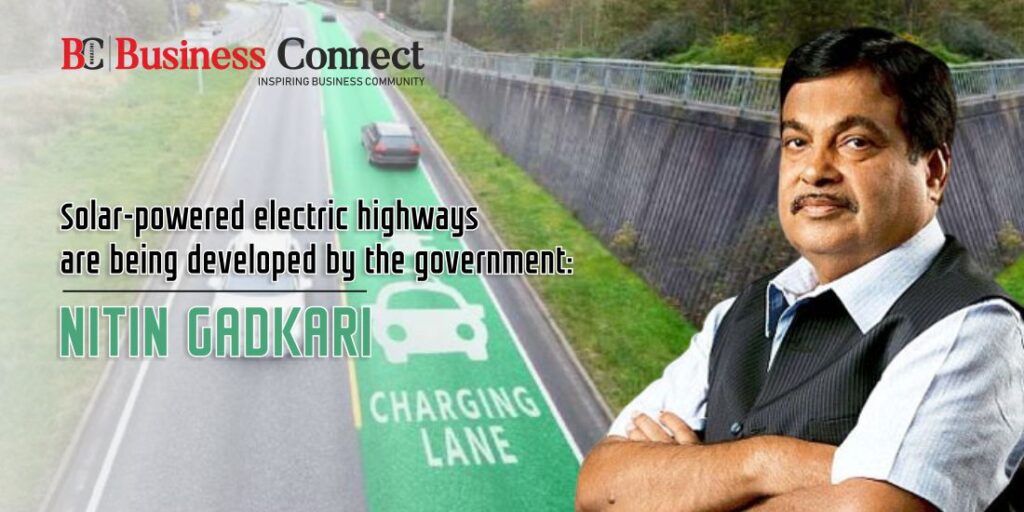Solar-powered electric highways are being developed by the government: Nitin Gadkari
Nitin Gadkari, the union minister for roads and highways, said on Monday that the government is working to build solar-powered electric highways that will make it easier to charge large trucks and buses. In remarks to a gathering hosted by the Indo-American Chamber of Commerce (IACC), Gadkari reaffirmed the government’s intention to build an electric public transportation system in India.
The use of solar and wind energy-based charging systems for electric vehicles is strongly encouraged by the government. He added, “We are also developing solar-powered electric highways, which will make it possible to charge buses and heavy-duty trucks while they are in motion.”
In general, an electric highway is a road that provides power to moving vehicles, including through overhead power lines. According to Gadkari, the government also promotes solar energy use in toll booths. The road ministry, according to the minister, has created a newer alignment and has performed route optimization exercises along important corridors.
Gadkari stated, “We are building 26 greenfield expressways,” underscoring the importance of having a well-developed infrastructure for boosting economic activity, fostering the growth of new companies, and fostering job growth. According to him, projects will receive quicker clearance with the implementation of the PM Gati Shakti Master Plan, which will also lower logistical costs.
The minister invited US private investors to invest in India’s logistics, ropeways, and cable car sectors, saying that both India and the US are natural partners. He said that the government is implementing tree plantation practises while building and expanding highways and that approximately 3 crore trees would be planted alongside the nation’s highways.
According to him, 27,000 trees have been successfully transplanted into national highway projects to date. Gadkari claims that the government is drafting a new policy known as “Tree Bank” for tree removal and tree planting. According to policy, organisations like the National Highways Authority of India (NHAI) and the National Highways and Infrastructure Development Corporation Limited (NHIDCL) are required to keep track of the trees they plant as part of project development in a tree bank account.
Automatic vehicle toll collection based on usage
According to Union Minister Nitin Gadkari, the Union government is also running a trial for an automatic number plate recognition system in an effort to ease traffic at toll booths and charge drivers according to the precise distance their vehicles travel on tolled highways. The automated number plate recognition system (cameras with automatic number plate readers) is being tested as part of a pilot project by the Ministry of Road Transport and Highways. This system will allow automated toll collection without requiring drivers to stop their cars.
Without providing more information, he stated, “With this new technology, we want to achieve two objectives — free flow of traffic on toll booths and pay as you go.” The typical wait time for cars at toll plazas during 2018–19 was eight minutes. The average wait time for vehicles has now decreased to 47 seconds as a result of the implementation of FASTags in 2020–2021 and 2021–2022.
Even though there has been a significant reduction in the waiting time, there are still some delays at toll plazas during rush hour at some locations, particularly those close to cities and in densely populated towns. Mr. Gadkari stated that the Advanced Traffic Management System (ATMS) is being installed on all recently built national highways as well as existing 4-plus lane national highways to provide seamless and safe traffic operation.
“The Ministry aims to implement the Intelligence Traffic System (ITS) on 15,000KM of the National Highway by 2024 to strengthen road safety,” the Road Transport and Highways Minister continued. The government is currently considering two options, according to Mr. Gadkari, who stated last month that they are number plates and a satellite-based toll system where the GPS is installed in the vehicle and the toll is directly deducted from the passenger’s bank account.
“We are in the process of using satellites to introduce GPS in place of FASTag, and we want to impose a toll on that basis. Technology is also present on licence plates, and India has good technology, Gadkari said. “We are going to choose the technology. Although we haven’t made a formal decision, in my opinion, a sophisticated computerised digital system will replace the toll plaza and there won’t be one thanks to the number plate technology. The Minister had stated that there wouldn’t be any lines and that people would feel a great deal of relief.



